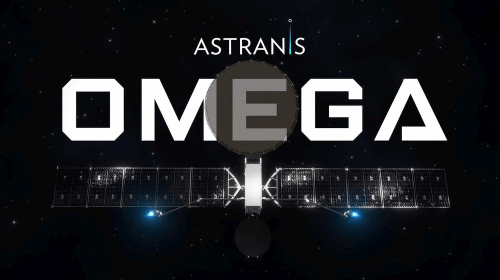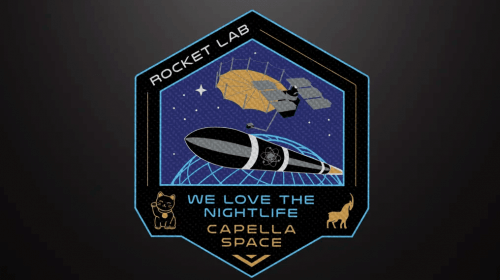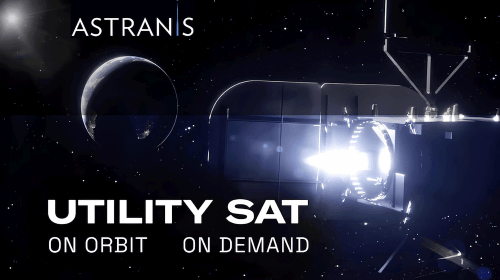Latest Developments in Identifying and Removing Space Debris
Oct 29, 2019
SpaceX has announced plans to launch an additional 30,000 satellites into Low Earth Orbit (LEO), bringing the total to 42,000 satellites, and raising renewed fears of space debris and the Kessler Syndrome. (Could Kessler Syndrome Put an End to NewSpace?). This is the concern that a crescendo of snowballing collisions in space could create a situation rendering space travel impossible for generations or even centuries. The Kessler Syndrome raises fears that a high-velocity piece of debris could hit a satellite, shattering it into a cloud of debris, that in turn can hit other satellites, in an ongoing, out-of-control escalation of collisions. Awareness of the problem began in 2009 when a US spacecraft accidentally collided with a Russian craft, creating a sort of debris belt and increasing the amount of large debris in LEO by about 70%. In March of 2019, India conducted an anti-satellite missile test that added thousands of bits of debris, when it blew up one of its spacecraft intentionally.
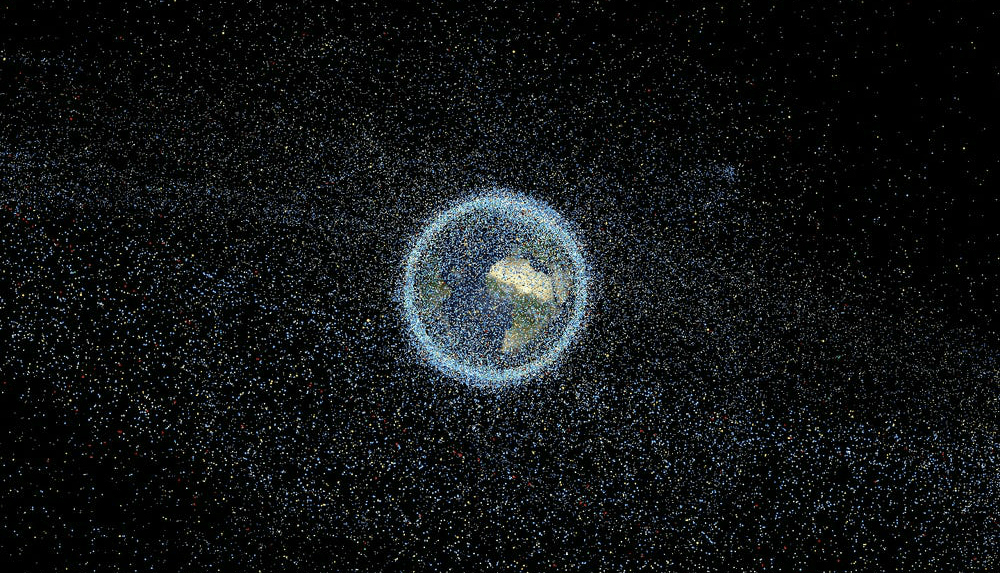 Illustration of space debris around Earth (Business Insider, October 15, 2019)
Illustration of space debris around Earth (Business Insider, October 15, 2019)
Interest in NewSpace opportunities that include CubeSats delivering IoT (Internet of Things) connectivity and mega-constellations of communications satellites such as SpaceX, OneWeb, Telesat LEO and others delivering global internet access, is expanding rapidly. As a result, the issue of space debris has been elevated to a position of prime importance. None of these NewSpace business plans can move forward if space is too inundated with debris to be used. As it turns out, proposals and product development have been put forth to address this critical issue. We’ll look at some of the progress here.
LeoLabs
The first issue to solve regarding space debris, is knowing where it is. LeoLabs, based in Menlo Park, California, is deploying a new Radar system in New Zealand that is expected to track approximately 250,000 dangerous objects smaller than 10 cm (4 inches) orbiting earth. This will be the first commercial device tracking debris that small. The new radar will join a larger radar network, also operated by LeoLabs that provides real-time data about larger objects in LEO. The data gathered by LeoLabs helps satellite operators and government agencies avoid catastrophic collisions with space debris. Increasing visibility of space debris to identify 250,000 small objects, is a big step forward, but with over 100 million bits of space junk in orbit from abandoned satellites, spacecraft broken apart, etc., this is just a start.
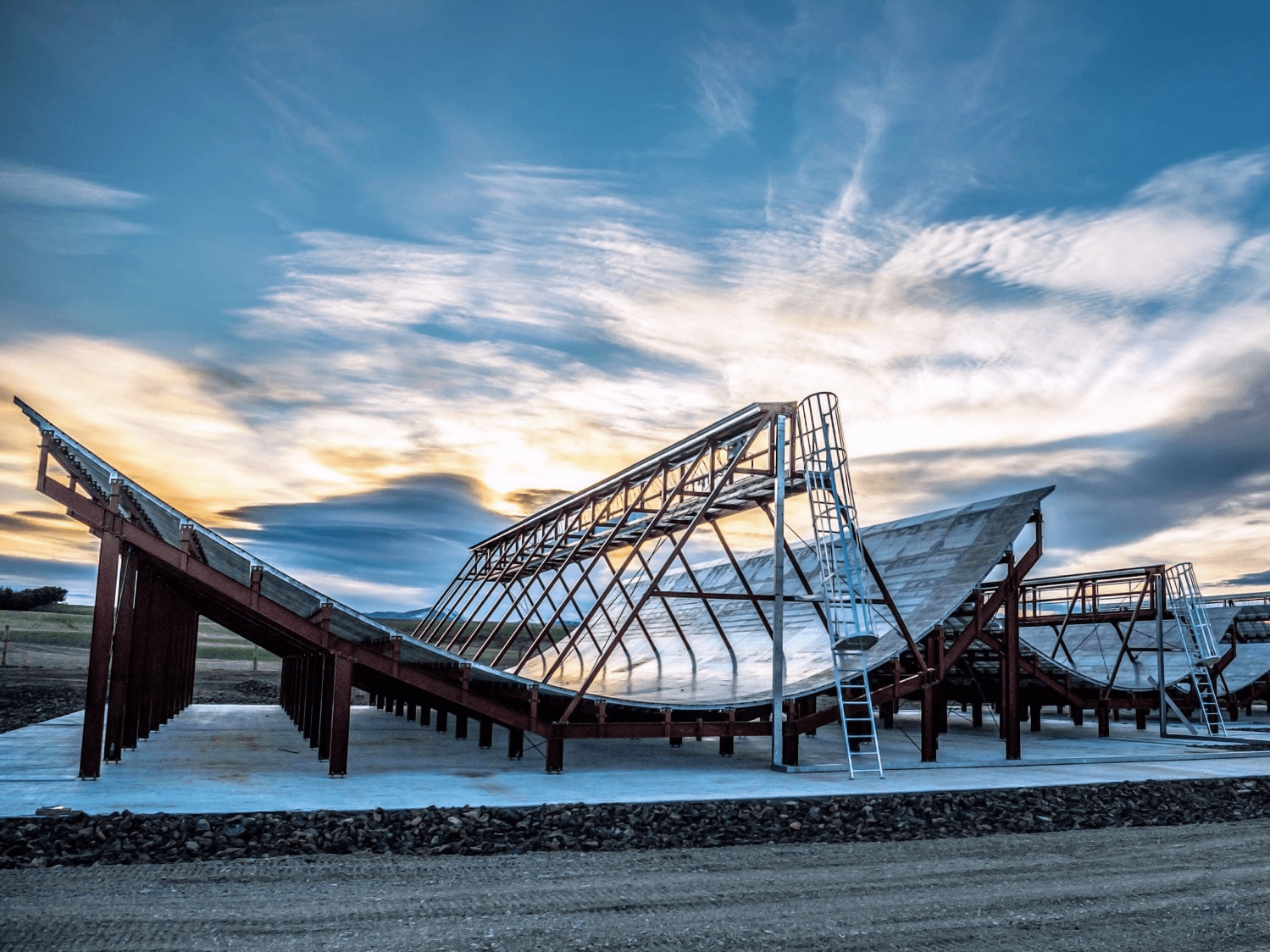 The Kiwi Space Radar is located in the Central Otago region of the southern island of New Zealand – LeoLabs – Business Insider (Oct 15, 2019)
The Kiwi Space Radar is located in the Central Otago region of the southern island of New Zealand – LeoLabs – Business Insider (Oct 15, 2019)
LeoLabs plans to offer a service to satellite operators and government agencies, informing them of potential collisions so they can take evasive maneuvers and move satellites out of danger. There is considerable interest in the new Radar, as it permits tracking smaller items than previously possible. The system works by sending pulses of radio waves into the sky and listening for echoes that come back from satellite and other space debris, similar in many ways to how bats use chirps of sound and echolocation to identify things. Leveraging long rows of hundreds of identical transmitters and receivers sending precisely timed signals, the radar tracks the movement of objects above earth. The new radar can identify objects 2 cm wide or larger.
In time, the company hopes to expand coverage by putting an array near the equator and a couple others closer to each of the Earth’s poles. By tracking debris better, the number of collisions will be reduced. The radar will be able to work with proposed “tow-truck” satellites designed to capture and remove large pieces of debris from space.
Astroscale ELSA-d
The End-of-Life Services by Astroscale-demonstration (ELSA-d) mission has completed the design reviews and subsystem testing for its space removal mission, and has begun the assembly, integration and test (AIT) phase. ELSA-d is the first commercial orbital debris removal mission designed to work in LEO. Two spacecraft, a Servicer (~180kg) and a Client (~20kg) will work in tandem with the expectation of demonstrating complex capture activities to remove space debris. The demonstration will have Servicer release and recapture Client in a series of tests. The project will demonstrate searching for and identifying the test object – Client. It will rendezvous, dock, and eventually de-orbit.
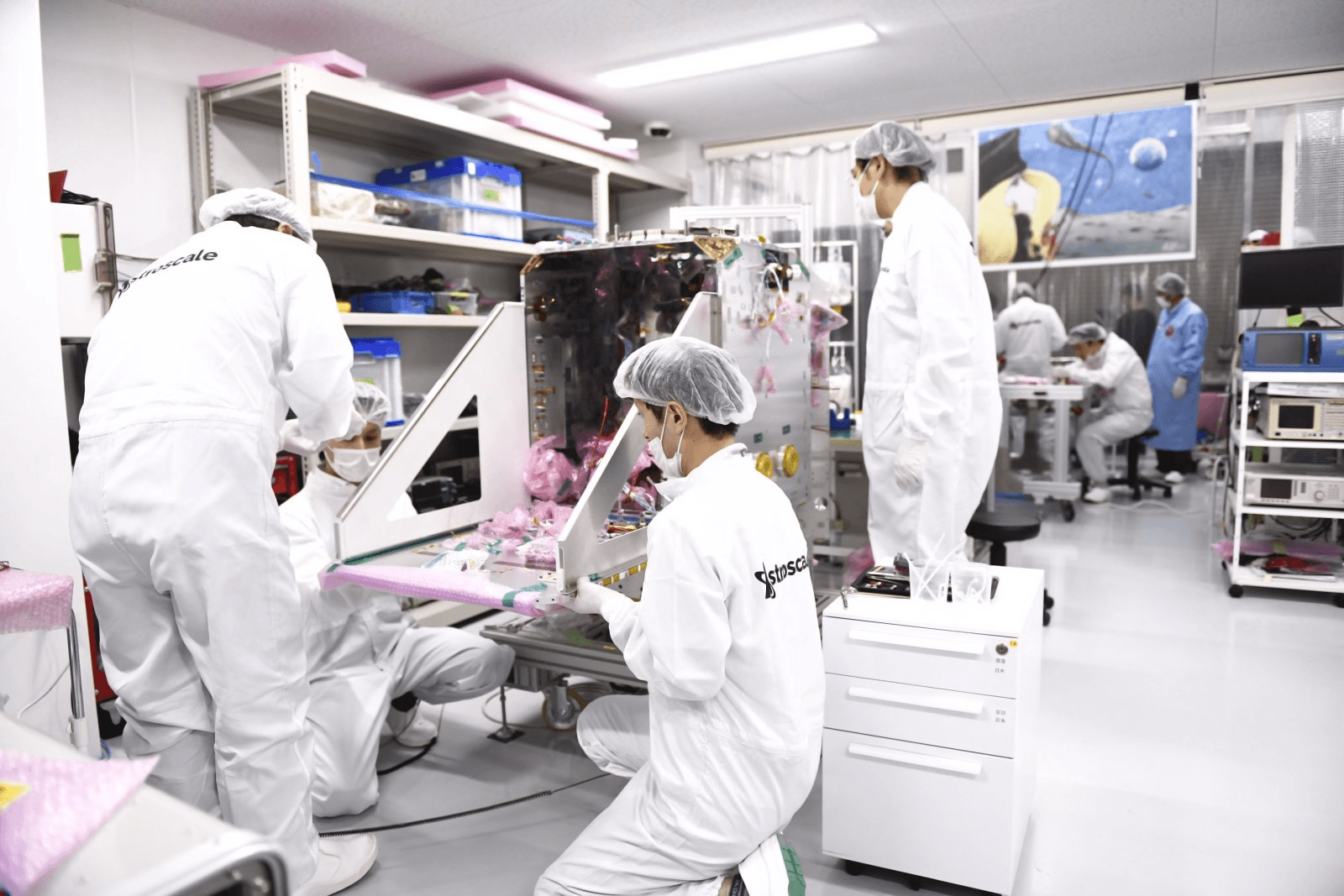 Construction is taking place at the company’s headquarters in Tokyo. ASTROSCALE (Forbes, Oct 11, 2019))
Construction is taking place at the company’s headquarters in Tokyo. ASTROSCALE (Forbes, Oct 11, 2019))
Cooperative rendezvous has been demonstrated in the past, (Putting a Net Around Space Junk) but ELSA-d plans to semi-autonomously capture an unresponsive, tumbling Client, a capability that will be required to move dead satellites or large pieces of space junk. Servicer will perform several tests. First Client will be released from Servicer, which will then approach and capture Client with a magnetic plate. Next, Client will be released and randomly spun. Servicer will approach and match the rotation of Client, and again attach with a magnetic plate. For the final test, Client will be “lost” in orbit. Servicer will attempt to locate it using its tracking system, enter a spiral-shaped elliptical orbit, and then again match rotation and grab Client with its magnetic plate. If all goes well, Servicer will then lower the orbit of both craft, descend into Earth’s orbit and burn up.
This solution is designed to address the large number of defunct spacecraft in orbit. Removing them, reduces the chances of a shattering impact event that could set off a Kessler Syndrome. Of the approximately 5000 satellites orbiting Earth today, 3000 of them are dead, and create increased risks for collisions. Commercial “Servicer” satellites present a feasible commercial business service to remove old satellites and pieces of rockets, as ELSA-d plans to demonstrate.
Who will pay for these services? In light of the recent event in which the ESA (European Space Agency) was forced to dodge a SpaceX satellite in a near-miss orbit, it seems clear that those who wish to commercialize space can only do so if they have a clean environment in which to work, or the entire enterprise is at tremendous risk, along, perhaps, with the quality of life for the rest of the world’s population.
Duck and Cover?
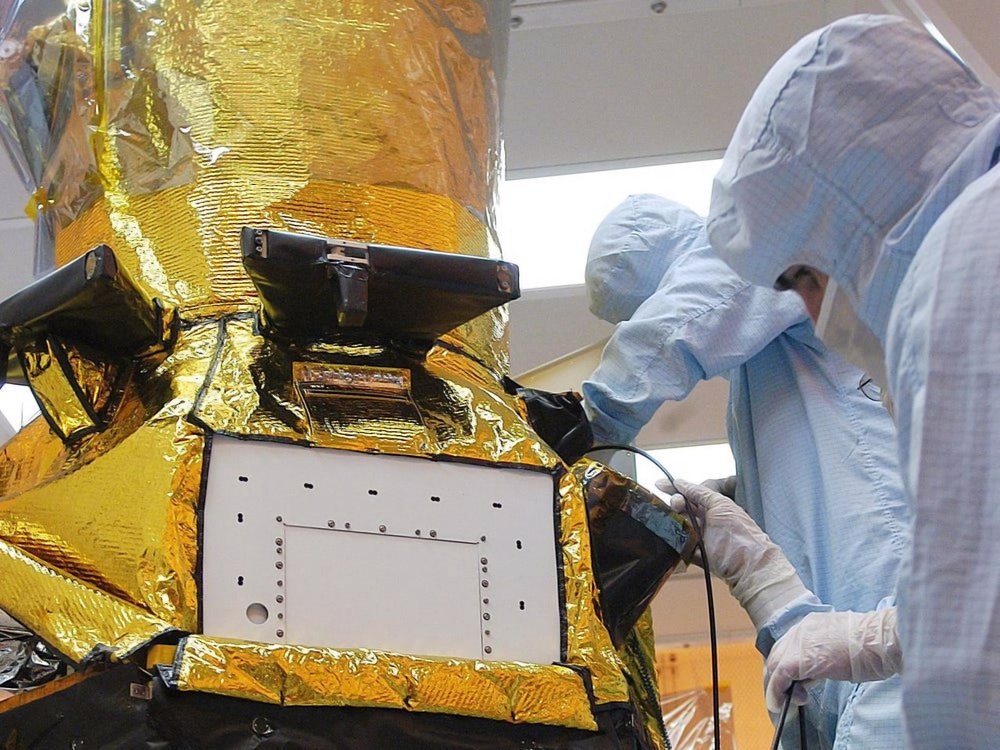 Technicians install Whipple debris shields on the GALEX spacecraft (NASA/KSC)
Technicians install Whipple debris shields on the GALEX spacecraft (NASA/KSC)
As plans continue to develop ways to clean up space junk, satellite manufacturers are looking to combine evasive solutions to help satellites get out of the way of larger pieces of space junk, with concurrently providing self-protection from the smaller bits. Whipple shields provide the self-protection and are used to protect spacecraft from small pieces of debris, up to about 1cm in size. They break up and disperse incoming debris.
Large pieces of debris can be tracked from the ground, and LeoLabs is on track to see even smaller objects, however there is still a middle ground of objects too large for Whipple shields to offer protection from, and too small to be seen in advance from ground Radar, so that avoidance movements can be performed. Scientists at the University of Arizona in a new study on space debris have been working on ways to help satellites operate on their own to avoid such objects. First would come onboard thermal infrared cameras which can detect extremely small levels of heat emitted from debris, from tens of miles away. This is still a very short distance, given how fast the debris is moving, so there would be only seconds to react. Rockets using solid propellants can activate in a fraction of a second for a fast, albeit rough, push out of the way. Solid rocket propellants are high-thrust, lightweight and very reliable.
The scientists, headed by aerospace engineer Jekan Thangavelautham, propose developing a CubeSat about the size of a loaf of bread, with 16 solid-propellant thrusters, a thermal infrared camera and a ceramic Whipple shield transparent to infrared rays. They suggest a simple design to keep the costs down. One issue for ongoing research is the thrusters. Solid propellant rockets can only be used once. The purpose of multiple thrusters is to provide multiple opportunities to evade debris. Also, under consideration are solid gels for propellant, as these can fire many times, “these could increase the number of times a satellite could dodge debris,” Thangavelautham said.
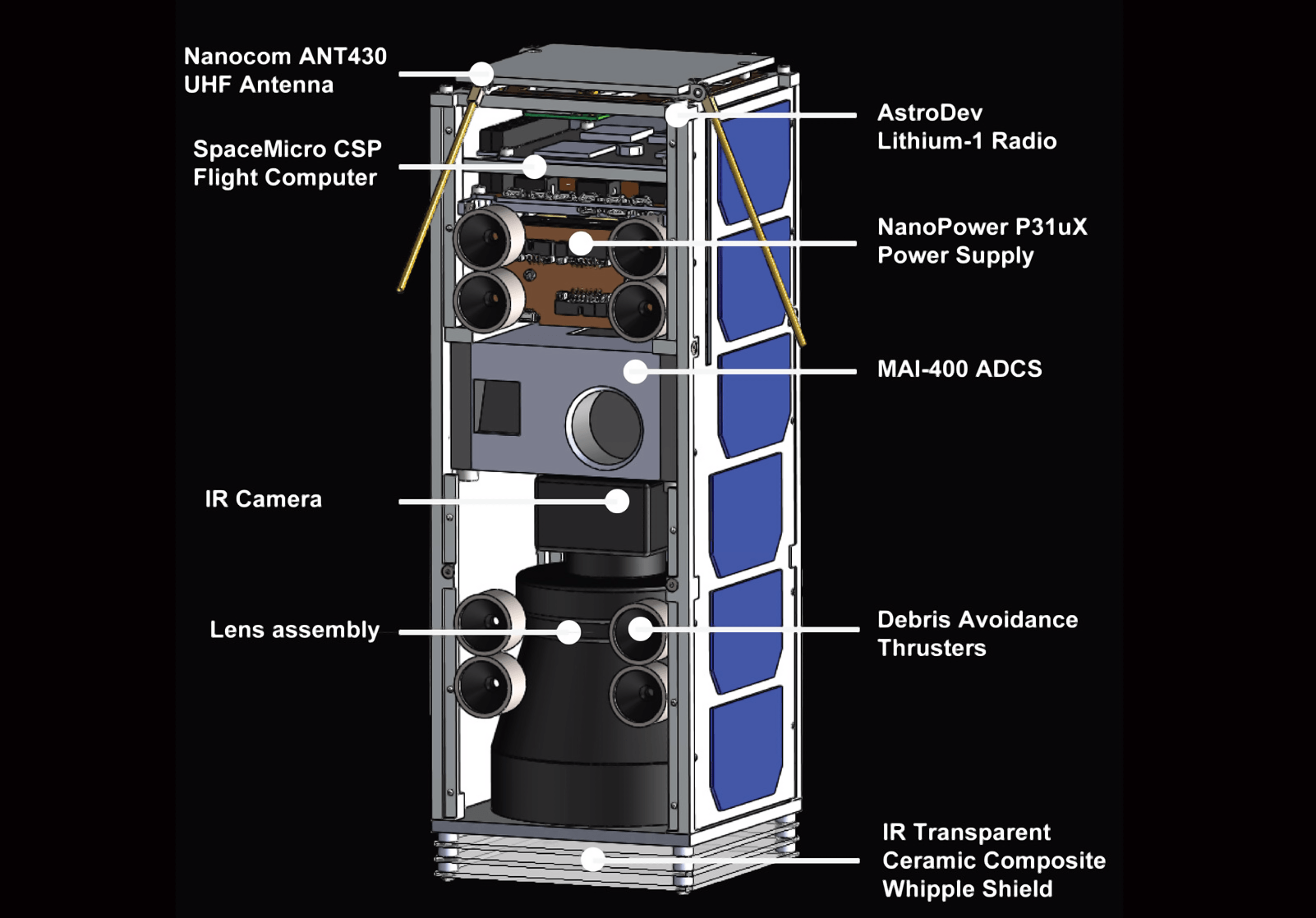 An illustration of a concept CubeSat equipped with gel-based thrusters and infrared cameras to track space junk. Image credit: Troy M. Jameson and Himangshu Kalita) Space.Com (Oct 2019)
An illustration of a concept CubeSat equipped with gel-based thrusters and infrared cameras to track space junk. Image credit: Troy M. Jameson and Himangshu Kalita) Space.Com (Oct 2019)
The ESA (European Space Agency) is taking this a step further, planning to leverage machine learning to protect satellites. Their collision avoidance system will automatically assess risk levels for in-space collisions and improve on the decision-making process to determine whether a maneuver is required. These decisions can also be communicated to operators on the ground as well as other satellites, to ensure that the maneuvers don’t create issues for other satellites. The process is likened to that of international air traffic control.
Today the process is entirely manual. Operators routinely protect their satellites in high-traffic orbits from potentially catastrophic collisions, by sending commands to their spacecraft to take evasive maneuvers. There are hundreds of alerts issued every week. Most collisions diminish in risk as time goes by, but for some risks, further action is required. In a recent example, one of SpaceX’s 60 experimental Starlink satellites, launched in May 2019, appeared to have a 1 in 1000 chance of hitting an ESA satellite, the Aeolus. ESA moved its satellite out of the way because SpaceX said it had “no plan to take action,” and blamed “buggy software.” Various teams are required to prepare maneuvers and upload commands to the satellite. Machine learning is expected to start taking over these tasks, making them more efficient and accurate as the machines learn.
GSO Orbital Cleaner
Thus far we’ve talked about cleaning up LEO orbits as that space is about to get very crowded. Geostationary orbit (GSO) also has its share of space debris. The relatively new $400-million Intelsat 29e satellite lost recently may have been hit by debris in a stationary orbit high above the equator. There are currently about 1000 inactive space objects in this region, mingling with critical communications satellites. Satellites in this orbit sit above the same space on earth, but they are still affected by gravitational pulls from the sun, moon and earth, leaving open the possibility of collisions. The Department of Theoretical Mechanics at Samara University in Russia has an original solution for these old satellites. Their plan is for a tug-collector, a very heavy satellite with low thrust engines that acts as a gravity trap. The heavy satellite will capture wayward objects and move them out of the GSO region. Originally scientists suggest a 100-ton tug-satellite but suggest that small asteroids could be used in the future.
The effects of gravity, whether from the earth, sun or moon, is very weak at these heights. Heavy objects create an area of their own gravitational attraction called the “Hill Sphere.” The heavy satellite will move slowly towards undesirable objects which will become ensnared in its gravitational field, which in turn increases the total combined mass, thereby increasing the strength of the attractive field. When the tug-satellite has captured enough material, it will take the debris up to a higher orbit out of the way of any commercial satellites. The Russian Science Foundation is supporting the project and the research team, having completed physical modeling is working on specific engineering calculations.
Space industry players are embracing and endorsing new guidelines designed to ensure that space debris is managed. Nobody wants to wait for a disaster before starting to act. Too much is riding on the commercialization of space in the decades ahead. The pace needs to pick up, however. On September 18, 2019 the Bigelow Aerospace’s Genesis II experimental habitat, and the Russia Cosmos 1300 satellite had a near miss. No evasive maneuvers were taken – both spacecraft are defunct and inoperable, just part of the ever-growing field of orbital debris…



